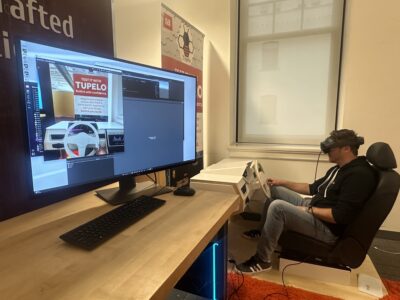For more than five years, a controversial private transit project to connect Pittsburgh’s major universities in Oakland with a nearby, nearly-200-acre development site has been in limbo as opponents and supporters debate who it will benefit, and at what cost.
When a new mayoral administration takes office in January, the Mon-Oakland Connector will be on hold, again.
Tené Croom, spokesperson for Mayor-Elect Ed Gainey, in a written statement to Technical.ly, said, “Consistent with his campaign position, upon taking office, the Mayor-elect intends to place the project on hold pending both an internal review and an independent review from the Controller’s office.”
The announcement further calls into question a major facet of the Hazelwood Green development, long touted as the largest undeveloped parcel of land in Pittsburgh proper. The site is currently facing questions about recently-proposed changes to zoning that could affect its impact on local traffic and the complexion of the development itself.
The roughly $23 million dollar Connector project, announced in 2015, centers around a six-mile shuttle route that would connect the city’s Oakland neighborhood, home to Carnegie Mellon University and the University of Pittsburgh, with Hazelwood and the 178-acre Hazelwood Green development site.
Further questions exist regarding the Connector’s impact on a simultaneous, overlapping stormwater project in the same area, which is designed to reduce combined sewer overflow flooding in the city’s Four Mile Run section of Greenfield.
In August and December of 2020, the Pittsburgh Water and Sewer Authority and the City of Pittsburgh’s Department of Mobility and Infrastructure (DOMI), filed a joint permit application with the Pennsylvania Department of Environmental Protection and the Army Corps of Engineers, respectively, which combined elements of the Mon-Oakland Connector Project with that of the Four Mile Run Watershed Plan.
“The Four Mile Run Stormwater Project and the Mon-Oakland Connector are separate projects that overlap because they occupy the same general land area,” says PWSA spokesperson Rebecca Zito. “Because the projects occupy the same general land area, they are required to have one contiguous erosion and sediment control plan, as well as one stormwater management plan during construction.”
Because the projects occupy the same general land area, they are required to have one contiguous erosion and sediment control plan, as well as one stormwater management plan during construction.
PWSA acknowledges that removing the Connector from the stormwater project could delay the stormwater project, as it would require the Authority to redesign certain details. At the same time, the state DEP continues to ask PWSA questions about the Connector’s relationship with the stormwater project in a pair of technical deficiency letters, which could itself trigger further review and delays.
Pittsburgh City Controller Michael Lamb confirmed his office’s review is part of an ongoing, regularly scheduled performance audit of DOMI, which began a few months earlier.
He said that the scope of the audit includes the Mon-Oakland Connector project. Lamb further stated the decision to link the Mon-Oakland Connector with the PWSA’s stormwater project is “something I have concerns about,” but would not go into further detail.
His stance is opposite that of current Pittsburgh Mayor Bill Peduto, as well as three of Pittsburgh’s major foundations. Today, Hazelwood Green is owned by the Richard King Mellon Foundation, the Heinz Endowments and the Claude Worthington Benedum Foundation. (The McCune Foundation sold its shares to RK Mellon in 2016.)
“Filing a joint permit was shown to save both PWSA and the City money,” said Peduto’s chief of staff, Dan Gilman. “Given the many [critical] projects that need to be completed by the City and PWSA, we want to save ratepayer/taxpayer dollars at every opportunity. This project is critical to both address repetitive flooding in the community and to create an [important] mobility link between Hazelwood and Oakland.”
PWSA also expressed a desire to save taxpayer dollars on permitting, stating, “it is our duty to coordinate on projects where substantial cost reductions and benefits are possible. This is a standard approach to avoid problems and unnecessary construction disruptions that can occur when utilities and City departments don’t work together.”
Shuttle plans
The foundations purchased the Hazelwood Green property for $10 million in 2002 under the name Almono LP. The site was part of a proposal to attract Amazon in Pittsburgh’s failed bid for HQ2, and has been envisioned as a sort of Silicon Brownfield: where LTV Steel’s coke plant once stood, now research teams and spinoff companies from Pitt and Carnegie Mellon would innovate and manufacture the industries of the future, while creating jobs in the process.
The electric shuttles under consideration would measure about the size of a Honda Odyssey minivan, and would accommodate between six and nine people at a time, running every 10 or 15 minutes in a loop between Oakland and Hazelwood. That puts the number of riders at 180 people per day.
Under the plan, the foundations will pay to operate the electric shuttles. Initially, they were proposed to be autonomous, but will now be driven by a human. The shuttles will run partially on public roads and then cut through Four Mile Run and run alongside the pedestrian and bike trail in Schenley Park, which would be widened to accommodate them.
Moreover, the foundations themselves acknowledge the shuttles are an “interim” solution to the area’s long-term transportation deficit. In their public report, “A People’s Audit of the Mon-Oakland Connector,” PPT argues for increased funding of existing bus routes instead as a more cost effective, reliable, and equitable alternative.

Proposed shuttles for the Mon-Oakland Connector (Screenshot via Hazelwood Green)
The Mon-Oakland Connector plan first came to light in an August 2015 Pittsburgh Post-Gazette article. Public meetings have been met with steady opposition from local residents since. Some of these residents, loosely organized as the Junction Coalition, as well as critics like Pittsburghers for Public Transit Executive Director Laura Chu Wiens, call it “development masquerading as infrastructure,” and a vanity project for whose money would be better spent on public transportation.
The binding of the stormwater and transportation projects is just the latest cause for consternation.
“It’s bonkers, in and of itself,” says Four Mile Run resident Barbara Warwick. “They’re holding our flood relief hostage.”
During his campaign, Gainey pledged to “stop the buildout of Mon-Oakland connector and prevent the construction of other privatized or quasi-privatized mass transit systems designed to support luxury development at the expense of existing residential communities.”
Despite Gainey’s opposition and election victory, the foundation owners of the site maintain their support for the project.
“The Almono partners continue to believe that the proposed Mon-Oakland Connector would be one valuable and catalytic solution to addressing the current absence of efficient and direct transportation between Oakland and Hazelwood,” said Todd Stern, managing director at U3 Advisors, development advisor to Almono L.P.
“CMU shares the goal of a development at Hazelwood Green that is inclusive of the local community, with a focus on sustainability and broad-based economic opportunity,” writes Shilpa Bakre, Interim Managing Director of Communications for CMU. “We look forward to partnering with Mayor-elect Gainey, Pittsburgh City Council, and the Greater Hazelwood Community on the future of this transformational development.”
David Seldin, Assistant Vice Chancellor for Communications at the University of Pittsburgh, said in an email inquiring about the Connector, “the University has no position on the proposal.”
Protecting The Run
At the heart of the struggle is Four Mile Run. It’s safe to say most Pittsburgh residents, unless they were visiting friends or happened to pop in for the wedding soup at Big Jim’s, haven’t been to this tight-knit, residential community of a few hundred. It’s tucked into the valley that isolates it from the rest of Greenfield proper, the neighborhood to which The Run, as it’s known, officially belongs.
“We really love it here,” says Warwick, who moved to The Run from Los Angeles with her husband and two children in 2014, drawn by its low-key locale and the adjacent city park. “We just want to be good neighbors and do what we can so that people here can benefit from [the neighborhood and its amenities] as we did when we got here.”
Despite their concern about the shuttle’s impact on their community and adjacent Schenley Park, the primary concern for most Four Mile Run residents remains flooding.
“The biggest thing for us is to get the DEP to approve the stormwater plan,” says District 5 City Councilperson Corey O’Connor, who represents Hazelwood and Greenfield, including The Run.
In December 2020, O’Connor negotiated to eliminate $4.1 million in the city budget for the Connector project and redirect the money elsewhere, including rental assistance, small business development, as well as $1 million for pedestrian infrastructure in Hazelwood.
The need for PWSA’s stormwater project is accelerated by climate change. Flood events such as those experienced by the Run are bound to become more intense and frequent. The area underwent a 75-year flood event in 2009, and a 25-year flood event in 2011, with further flooding in 2016 and 2021, among others. Photos show streets and basements in low-lying portions of the neighborhood overwhelmed with combined sewage overflow during storms.
“The [Four Mile Run] stormwater project provides protection up to a 10-year storm and reduces the impacts of flooding by incorporating new stormwater infrastructure from Panther Hollow Lake to the Monongahela River,” wrote Zito, the PWSA spokesperson, in a statement.

A collage shows flooding events in The Run over the last 15 years. (Photo courtesy of Junction Coalition)
It’s unclear yet if or how the two projects will be extricated from one another. O’Connor says it is something being looked at, but the Connector will still have an impact on the stormwater project, no matter the final decision.
“As an example, if the MOC does not move forward PWSA will, at a minimum,…need to redesign the site restoration to put back existing trails. The cost and schedule impacts of such a change are unknown at this time,” writes Zito.
At the same time, the DEP continues to ask questions about the stormwater project as it stands with the Connector intertwined in the application. (PWSA says that the Army Corps of Engineers has approved its portion of the joint permit application.)
In a technical deficiency letter, dated October 29, 2021, DEP again asked PWSA to clarify the impact of the trail on certain parts of the stream, as well as to articulate the connection between the Four Mile Run Stormwater Improvement Project and the City of Pittsburgh’s Mon-Oakland Mobility Project.
“If there are additional components and/ or sections of the overall DOMI Trail/Mon-Oakland Mobility Project, please note that a Comprehensive Environmental Assessment may be requested,” reads DEP’s letter.
Even before the joint applications were submitted, Gilman, Peduto’s chief of staff, called the overall project, in a January 2019 meeting with foundation and university representatives, “a clusterf—,” and “in critical jeopardy of losing public trust.”
Despite ongoing questions about the connector, momentum continues to build at Hazelwood Green.
In May, the RK Mellon Foundation granted Carnegie Mellon $75 million toward a new robotics innovation center and advanced materials and manufacturing institute at the site. Just this month, the University of Pittsburgh received $100 million from the RK Mellon Foundation for a new biomanufacturing facility at the Hazelwood Green. The site also received a $10 million state grant in 2014, and is already home to Advanced Robotics of Manufacturing Institute (ARM), a public-private partnership between CMU and other manufacturers initially seeded by the Department of Defense.
And just this month, Almono contracted with NY development firm Tishman Speyer, owners of Rockefeller Center and other commercial sites, to develop Hazelwood Green.
“We recognize the concerns that some members of the community have raised,” said Stern, the Almono advisor. “We will be mindful of those concerns as we continue to work with our public agency partners and stakeholders to support comprehensive regional transit solutions.”

This editorial series is underwritten by Pittsburgh Innovation District. This article was not reviewed before publication. Learn more here and sign up for our weekly newsletter on jobs in the region here.
Before you go...
Please consider supporting Technical.ly to keep our independent journalism strong. Unlike most business-focused media outlets, we don’t have a paywall. Instead, we count on your personal and organizational support.
Join our growing Slack community
Join 5,000 tech professionals and entrepreneurs in our community Slack today!

Millions of dollars pour into semiconductor manufacturing in Southwestern PA

This Week in Jobs: Travel far in your career with these 26 open tech roles

This company is using AR headsets to offer detailed insights on how customers shop


